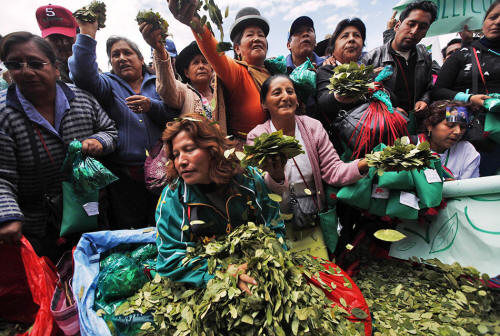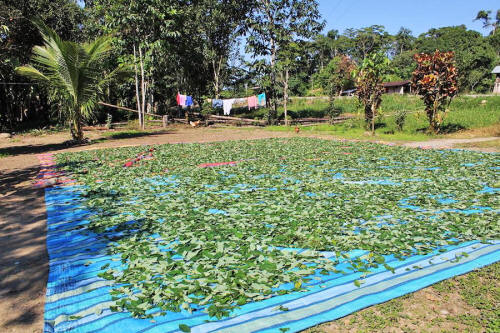|
from
Vice Website
The Pulitzer Center on Crisis Reporting funded the travel for this story.
Sitting barefoot on a log, a farmer surveys more than 200 pounds of coca leaves drying out in front of his ramshackle lean-to here in the rainforest of the Chapare region, the muggy heart of Bolivia's coca country.
The leaves, he says, represent one of his three harvests per year, grown under Bolivia's policy of legal but regulated production of the crop.
Each harvest will fetch about $200 at market, but half of that goes toward expenses, including pesticides and wages for locals who help pluck the ripe leaves quickly before they spoil.
As he chews a thick wad of the leaves, the farmer recalls how much more difficult his daily life was when coca production was still illegal in the country.
Coca, a mild stimulant, has been used for millennia by people in the Andes in tea and food, though it is most often chewed raw to give energy and treat ailments ranging from altitude sickness to menstruation pain.
The plant is also the source material for cocaine and the target of anti-narcotics (failed) efforts across South America driven in part by the United States.
From 1997 to 2004, a US-funded program seeking to eradicate coca in Bolivia by force plunged the Chapare into traumatic conflict.
Even though his crop has been fully legal since 2004, when the Bolivian government took the unprecedented step of legalizing production for domestic consumption, these dark memories still prompt the farmer to insist his name does not appear in print.
Wherever you go in the Chapare - one of Bolivia's two coca-growing regions - you hear similar stories of life in the 1990s and early 2000s:
You also hear gratitude that Bolivia has replaced a strategy of eradication with one of regulated production to meet historic national demand for coca.
Farmers feel particularly indebted to President Evo Morales, a former firebrand coca growers' leader from the Chapare.
Morales expelled the DEA from Bolivia in 2008 after violent confrontations in the region claimed 30 lives and he said he could no longer guarantee the US agents' safety.
The 2004 legalization ushered in a close working relationship with the United Nations Office on Drugs and Crime, whose estimates of land dedicated to coca in the three countries where the plant is grown,
...are widely used to calculate how much cocaine is circulating in the world.
The UN agency helps the Bolivian government track land used for coca with satellite images and backs on-the-ground visits by a small army of inspectors.
According to the agency's annual survey of Bolivia's coca sector, published in July, the country's area of production dropped slightly in 2015 to 20,200 hectares.
That's the lowest level since the agency began monitoring Bolivia's coca harvest in 2003 and roughly a third down from the total during the DEA's last year in Bolivia.
It is also almost exactly at the national target of 20,000 hectares - enough to meet local demand for the plant while still ensuring minimal leakage into cocaine production.
Photo by Simeon Tegel/VICE
News
It might look like success, but
Bolivia's ground-breaking coca reform is not popular in Washington. Earlier this month, President Barack Obama underlined US disapproval when he officially declared, through a State Department memo, that Bolivia has "demonstrably failed" to live up to its international counter-narcotics commitments.
The only other countries on the list were Venezuela and Burma.
A State Department spokesperson told VICE News in an email that Bolivia had "undertaken some successful counter-narcotics activities," but added that the country has not destroyed enough coca plants nor seized enough cocaine in transit to merit US approval.
Morales has made it clear he doesn't care what the US thinks.
Morales built his political career in the 1990s and early 2000s by leading a coca growers' union in the Chapare, where he spearheaded heated anti-eradication protests at the height of the DEA's influence.
Legalization actually began under centrist President Carlos Mesa, a year before Morales won his first election in 2005.
The system - later dubbed by Morales as "coca yes, cocaine no" - allows each family to cultivate up to 1,600 square meters, known as a "cato," of coca plants. Farmers are obliged to sell their leaves at authorized markets, and if they cannot produce a receipt, they must justify why their harvest was lost (for example, because of blight) with a certificate from their local growers' association.
Exceeding quotas can lead to punishments such as pulling up some, or all, of a farmer's coca plants. In the Chapare, neighborhood committees check that none of their members exceeds the cato and report transgressors to the authorities.
The government also helps farmers willing to grow other crops such as citrus fruit, peanuts, yuca, and rice.
Grants from the European Union promote the substitution of coca with aquaculture using local Amazonian fish.
Washington's continued chastising of Bolivia stands in contrast to its routine approval of the eradication-based anti-narcotics efforts of staunch regional allies Colombia and Peru, which both grow far more coca.
Strategies in those countries can seem like a whack-a-mole game in which destroying crops in one area leads to them popping up somewhere else. Critics warn eradication does nothing to reduce demand for coca for the production of cocaine, nor poverty among the growers.
The UN crime office reported that Peru had 40,300 hectares of coca in 2015, almost exactly the same amount it registered in 2001 - the earliest year the agency compiled statistics for the nation.
Colombia, meanwhile, saw its coca production soar 40 percent last year, according to the agency, to 96,000 hectares. That's still down by roughly one-third from 2001, but it continues a sharp uptick since Colombia's coca low point in 2013.
The link between the number of hectares farmed and the amount of cocaine produced is complicated by varying soils, climate, latitude, and processing techniques. Most experts believe that Colombian yields are greater than those in Bolivia or Peru thanks to more advanced processing and natural conditions allowing for four harvests per year.
The United Nations crime office estimated that Colombia's 2015 coca harvest had a "potential" yield of 646 tons of cocaine, most of which makes its way to the United States.
The UN made no equivalent calculation for the amount of the drug produced in Bolivia or Peru, which tend to supply different markets, in Asia, Europe, and South America.
Large quantities of Peruvian cocaine continue to pass into Bolivia via light aircraft and backpackers who haul bricks of the drug through the dense, mountainous cloud forest of the frontier region.
Tim Torlot, the European Union's ambassador in La Paz, says he would like to see Bolivia interdict more of the drug, yet he still signs off on the country's overall strategy.
For Roxana Argando˝a, a 49-year-old coca farmer and mother of four who lives on the fringes of the small town of Villa Tunari, the biggest benefit of legalization has been the end of the climate of fear.
Argando˝a is a prominent local member of the ruling Movement Towards Socialism party, known as MAS, and is in charge of the municipality's human rights program.
She says she used to spend her time attending to cases of beatings, murders, and disappearances related to the coca conflict.
Now, she says she mainly deals with domestic violence.
|



